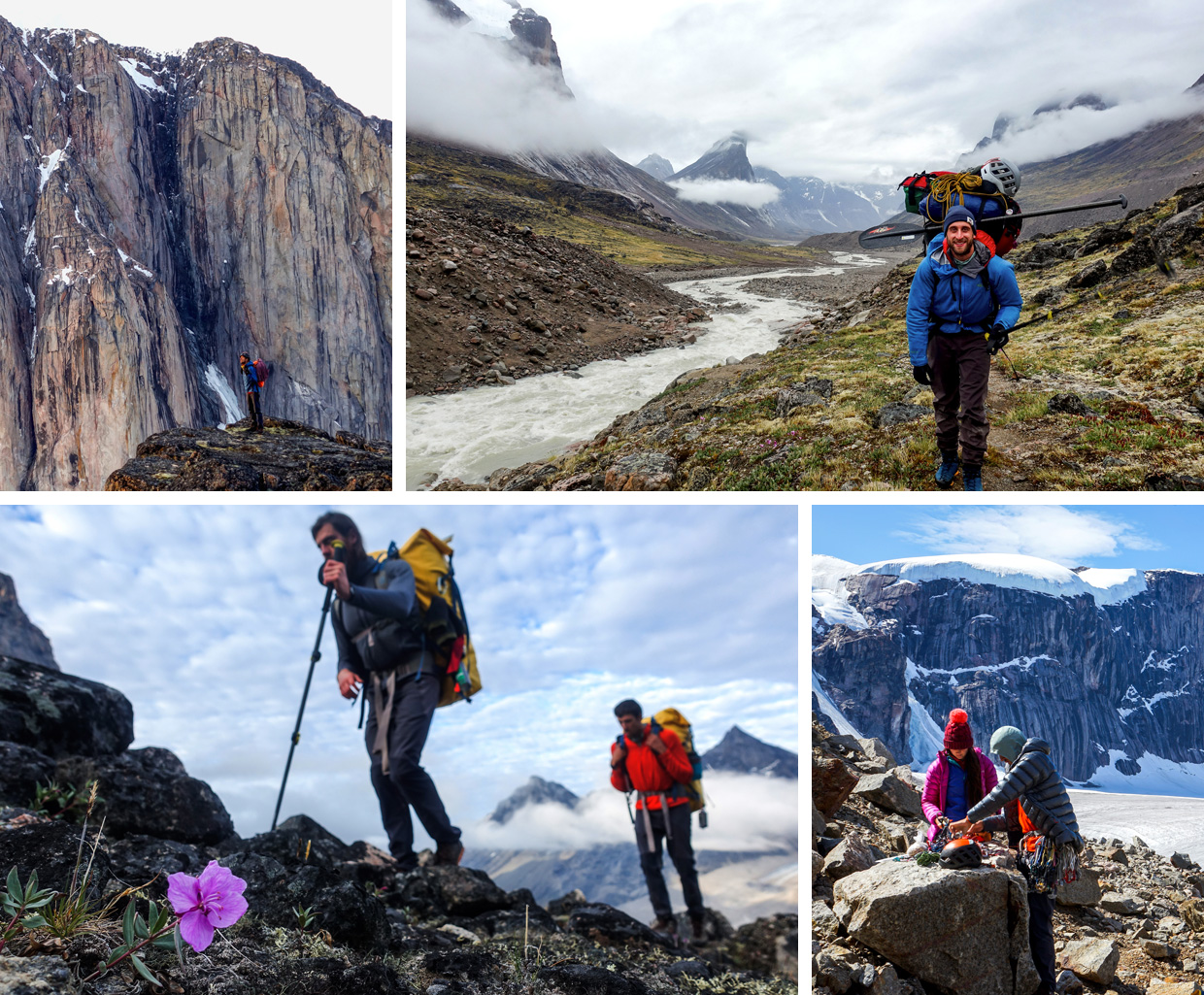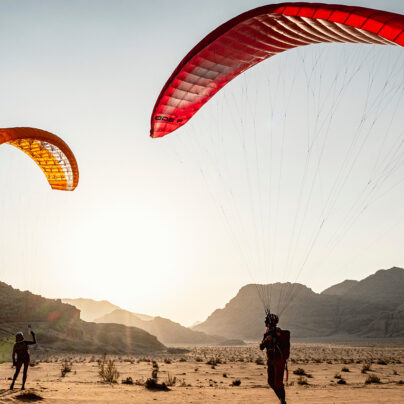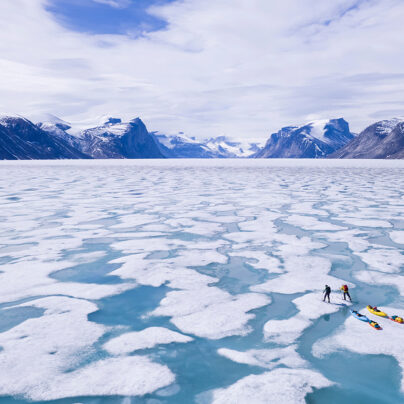Ocean to Asgard
A Climbing Expedition on Baffin Island
Written by Bronwyn Hodgins // Photography: Bronwyn Hodgins & Jacob Cook
At midnight Jacob and I stand atop the North Tower. Despite the biting cold, there’s not a breath of wind. It feels like we’ve landed on another planet. Nothing lives here. Only big flat boulders set off-kilter as if placed by a giant hand.
I breathe heavily as we race up the rock, and throw my hands and feet down wherever they land – there’s no time to choose specific holds. I propel my body upwards, chasing the tug of the rope, chasing Jacob, who charges on above me. I know how Jacob is feeling. He’s ecstatic to be moving over rock; the comfortable familiarity of the granite masks all fears of the unpredictable melting landscape as we leave it further and further below us.
He climbs 60m, plugs a crack with a camming device to protect him if I should fall, and then charges on. Another 60m, another single piece of gear. My calves are burning and I’m starting to sweat through my merino wool. I feel like I’m midway through a foot race, not halfway up Mount Asgard’s North Tower in the Canadian Arctic, taking on the Scott-Hennek Route’s full 1,000m of vertical climbing. Finally, Jacob stops to belay. I catch him and pause to gulp down some water before leading the next simul-block up to the steepening headwall.
We start pitched climbing here. It feels like a snail’s pace in comparison, and, as I belay, I finally have time to look around us. Jagged, snow-capped mountains stretch in every direction. To the west, the peaks become engulfed by the Penny Ice Cap. To the south I can just make out a shimmer on the horizon – the Arctic Ocean. The nearest people are 60km away to the south in the small Inuit community of Pangnirtung. Despite the lack of life, our surroundings are anything but silent. Every 20 minutes I shudder as another gully avalanches, sending rock and snow cascading violently down onto the glacier. We’re in the first heatwave of the year and the frozen landscape is weeping.
‘On Belay!’ Jacob calls out above me.
‘Climbing!’ I reply – always a partnership.
I first met Jacob in 2012 in the Leeds University Mountaineering Club. I was a Canadian exchange student and a total beginner rock climber. My first club trip was a weekend to Tremadog in Wales. We arrived at the hut after dark, and while the other students pulled out their drinks in typical university club fashion, Jacob and I grabbed our head lamps and started up a three-pitch HS by moonlight. It was my first multipitch and only my fourth time climbing outside. Little did I know that my life had just set its course – and that seven years later Jacob and I would be celebrating our one-year wedding anniversary on the towers of Asgard.
At midnight Jacob and I stand atop the North Tower. Despite the biting cold, there’s not a breath of wind. It feels like we’ve landed on another planet. Nothing lives here. Only big flat boulders set off-kilter as if placed by a giant hand. We watch the Arctic sun dip below the mountainous horizon. For just a few minutes we are covered in a purple dusk, then the fiery golden ball rises again, casting a new light on our little flat planet, while the icy world far below us remains in shadow. I turn on the radio to check in with our teammates Zack and Thor. ‘We’re at the top! How are you guys getting on?’ I ask, basking in the glow of success as much as the new day’s sun. ‘Awesome! We can’t see the top yet…’ Thor radios back.



I’ve known Zack and Thor my whole life. They are two of my closest friends. Before coming on this trip they didn’t have impressive climbing resumes, but I knew they were hard-working and would embrace any challenge with relentlessly positive attitudes. I’d introduced both of them to climbing and I can’t help but feel a sense of pride seeing them attempt a first ascent out here, but I also feel a certain responsibility.
Jacob and I descend via the notch between the North and South Towers, a wide loose gully where one slip could send rocks tumbling towards your partner. We force our tired minds to stay alert. Halfway down the gully, we check in again. We can see them now, little silhouettes on the summit of a previously unclimbed sub-peak of Mount Midgard. We discuss their descent options on the radio and they decide to rappel the face, retracing the way they came. I look up nervously at the huge swathe of granite. I trust them. They’ll be fine. I hope.
Back at the tents Jacob and I continue with bi-hourly check-ins. After 27 hours on the go, the boys stagger wide-eyed into camp. Jacob gets up to greet them; I roll over and immediately fall into a deep sleep. The tent is safe and cosy under the heat of the midday sun.
***
I wake up feeling like I’ve been steamrolled. My body aches all over, my hands are cut and swollen, my lips are chapped, and, above all, my mind is fried from the constant stress of impending danger. I need a break. We all do.
So far the trip has been a whirlwind of non-stop intensity. Two weeks earlier we’d arrived on Baffin Island, the largest island in the Canadian Arctic. Our team of four had set sail from Pangnirtung, paddling inflatable packrafts 30km up the ocean fjord. We’d then hiked another 30km with insanely heavy packs, retrieved our food and gear cache, and continued up the Parade and Caribou Glaciers to make high camp under Mount Asgard.
Hustled by incredible weather, over the next week Jacob and I had established our new route Never Laugh at Live Dragons, 5.10+ (E2) 600m, and repeated the Scott-Hennek Route, 5.11 (E4) 1,000m, summitting both towers of Asgard. Zack and Thor had also repeated a route on Asgard and established Beach Vacation, 5.10+ (E3) 600m, on the neighbouring Mount Midgard. We can’t believe our luck – but our minds and bodies have taken a proper beating.
We pack up camp and retreat into the valley, away from the constant avalanches and rockfall, away from the creaking glaciers and bottomless crevasses. Down by the river Arctic wildflowers have bloomed, painting the dull land with splotches of reds and pinks. We see an Arctic hare – the first wildlife of the trip! – its coat half white, half brown as it transitions into the short summer season. Thick clouds roll in and the temperature plummets. We bundle up in preparation for the storm. In a strange way we welcome the poor weather; maybe we’re not yet ready to face another big mountain. Instead, we settle into playing cards, cooking tasty meals, and listening to Zack’s novice rendition of the Jurassic Park theme song on the penny whistle.
Thick clouds roll in and the temperature plummets. We bundle up in preparation for the storm. In a strange way we welcome the poor weather; maybe we’re not yet ready to face another big mountain.




‘Rock!’ I scream in horror as I accidentally dislodge a huge flake that crashes down the open corner towards Zack and Thor. The flake hits the wall just above them and explodes into a million pieces, showering them in dust.
After the storm, it’s time to start making our way down the Weasel River valley. Time to inflate the packrafts. I’ve been paddling my whole life. My parents were northern river guides back in the ‘80s. I went to canoe camp every summer and then worked as a river guide myself for seven seasons. The boys, however, have only a little river experience. I will be making the call for what is safe to run – and what isn’t – on this raging glacial river.
We charge downstream in our tandem red packraft. I’m in the stern and Jacob kneels in my bow. The water is churning. It’s tough to spot the line as we race along dodging rocks and waves. We sneak just left of a big curling wave and then beach ourselves on a gravel bar.
Where are they? Thor and Zack had been right behind us. I start running back up the shore. Then I see them whip around the last bend, but they’re heading straight for that curling wave and suddenly the boat is upside down and they’re in the water. I start running again. Before I get there they’ve scrambled onto the rocks and Thor is reeling in the raft. They’re safe. But the water is frigid; they’ll be cold. I quickly help drain the boat and we all ferry across to the main shore to change into dry clothes. Despite the scare everyone is in surprisingly high spirits.
***
Further downstream we attempt the 700m west face of Mount Tirokwa. ‘Rock!’ I scream in horror as I accidentally dislodge a huge flake that crashes down the open corner towards Zack and Thor. The flake hits the wall just above them and explodes into a million pieces, showering them in dust. Holds are crumbling in my fingertips. We need to get off this mountain. ‘Let’s catch up to Jacob, and then chat about our options.’ My directness masks the emotions churning inside. When we arrive at the anchor, Jacob has come to the same conclusion: this isn’t worth it. We bail.
At camp, the sun is hot but the mood is heavy. Why do we go on these adventures? Where is our line between acceptable and unacceptable risk? We make pan-fry pizza and play on some of the boulders scattered throughout our camp, but we’re feeling burnt out and scared, unsure if we want to climb any more big mountains, at least not on this trip – maybe not ever.
We take our time enjoying the lower river, sometimes even carrying back up and running a sweet rapid multiple times. We inflate our large alpine flamingo, and try riding her through the rolling waves – how absurd! I feel a renewed appreciation and gratitude to be in this place with these humans. This is why we are here. To live in the present; to immerse ourselves in the beauty of the natural world; to build shared experiences and connections with those we love.
A few days later, the current spits us into the ocean and we set up camp at the edge of the tidal mudflats. Towering on the hillside above our beach camp is Mount Ulu. Our motivation and confidence rekindled, we have just enough time for one final push. Zack and Thor set off for the slabby south face of Ulu; Jacob and I for the steeper north face. Nearing the base, however, Jacob and I pause to stare up at the dark wall draped in shadow. My mood plummets as we watch rock pellets tumble down the hollow cliff. I point to another mountain just north of Ulu. A striking tower protrudes up the centre of a golden wall, facing west and glowing in the afternoon sun.



That night we sleep on inflatable portaledges halfway up the unnamed tower. A laser crack rises from our free-hanging camp, splitting the immaculate headwall above as if a goblin’s sword had sliced through the rock monolith like butter. We can’t believe our luck stumbling upon this unclimbed beauty.
Over two days, Jacob and I establish the Niv Mizzet Line, 5.13- (E7) 400m; Jacob manages to free the route. Standing on the pinnacle summit, I hear a faint shout. We look out across the cirque as two miniature silhouettes appear, barely visible, on top of Mount Ulu – Zack and Thor! For the next minute or so we cheer back and forth, the granite walls echoing and amplifying our joyful howls. My chest fills with overwhelming compassion and deep contentment as we stand there, each pair on their final summit of this wild journey.
We descend through the night to our seaside camp, elated and utterly exhausted, and, just like that, the trip draws to a close. We inflate our rafts for a final time and push off into the fjord, timing our departure so the tug of the falling tide sucks us out to sea, away from the mountains that have been our home. A deep dusk settles over us, and we can see the moon and a few faint stars overhead.
My arms perform the paddle strokes, but my exhausted mind wanders. I pause to look at Jacob in my stern, his eyes glazed over, his arms on autopilot just like mine. I love him. I love being able to go on this adventure with my life partner. But I also know it’s dangerous, and I don’t know what I would do if I lost him. I shudder. We turn the corner and the lights of Pangnirtung come into view – the finish line. Thor and Zack start bellowing an Irish sea shanty. I love these guys too. They feel like family. We press on as daylight starts creeping back across the sky, but the sea remains calm. We glide though the water, each stroke bringing us closer to those distant lights.
***
In Pangnirtung, we have one final important mission. The Inuit peoples are known for their resilience, living in some of the harshest conditions in the world. Yet, across the region, communities are suffering. After the fur trade died out in the ‘40s, governments stepped in to ‘teach’ the Inuit their modern ways. Many were forced to settle in permanent communities, giving up their traditional life of hunting off the sea and land. Others were sent south to residential schools, notorious for their child abuse. The Inuit are working to reclaim their traditions, culture, and language, but many of the youth are stuck with an identity dilemma: do I follow the traditions of my ancestors or do I follow the modern lifestyle that we were forced to conform to? Suicide rates in Nunavut are among the highest in the world. In Pangnirtung the youth centre ran out of funding in 2015 and was forced to close, leaving no safe space for youth to socialise and little access to mental health services.
We put up posters around the town for a day of rock climbing. The following afternoon, 20 youths show up. They especially love wearing the helmet with Thor’s horns. ‘Can we do it again tomorrow?’ one boy asks. Sadly, we are heading home. However, with a little information sharing we hope that future climbers in the area can take the kids out again. Of course, we acknowledge that hanging a few ropes for a day does little to reconcile the horrible impacts of colonialism, but at the very least we hope to encourage travellers to engage with local communities, and that through learning and compassion we may see more efforts to protect these peoples, their cultures, and the beautiful, wild land.
Bronwyn and Jacob are rock and mountain athletes who have set standards for modern big wall climbing on the world’s biggest cliff faces. They set ambitious goals and challenge themselves, but at the same time try to stay lighthearted and have fun. Bronwyn was the first Canadian female to free climb Yosemite’s El Capitan and is an ACMG-certified rock guide. Jacob is an elite big wall free climber – when off the cliffs he is also a mathematics professor at Quest University in Squamish.
Website: bronandjacob.com
Instagram: @bronwynhodgins
Instagram: @jacobcookclimbs
My arms perform the paddle strokes, but my exhausted mind wanders. I pause to look at Jacob in my stern, his eyes glazed over, his arms on autopilot just like mine. I love him. I love being able to go on this adventure with my life partner. But I also know it’s dangerous, and I don’t know what I would do if I lost him. I shudder.





